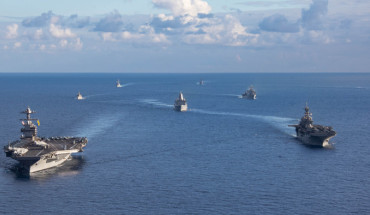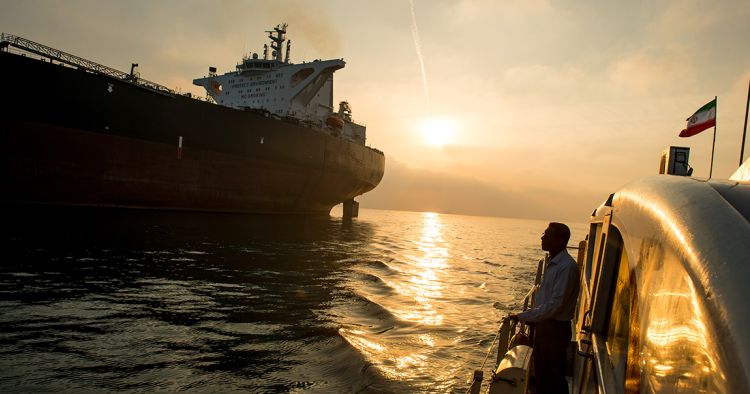On April 21, the US House of Representatives passed the long-awaited aid package for Israel, Ukraine, and Taiwan. Contained within the language of the legislation was another long-sought-after measure: authority for the US government to tighten restrictions on Iran’s oil exports.
The package, which was subsequently passed by the Senate on April 23 and signed into law by President Joe Biden the next day, suggests an increased appetite in the US to get tough on Iran’s oil sales in the wake of its unprecedented direct missile and drone attack on Israel on April 13.
But in truth, aggressive US action targeting Iranian oil remains unlikely, with the language of the aid package largely a symbolic gesture. While the package offers more power to the US government, expanding sanctions authority to target Chinese refiners buying Iranian crude and tanker companies knowingly transporting it, it remains the government’s prerogative whether to use that power. And there remain powerful operational, strategic, and political barriers preventing the US from shutting down Iran’s oil trade or hindering it in a material way.
Operational barriers
The first barrier is operational. To put it bluntly, sanctions don’t work like they used to. When the US exited the Iran nuclear deal in 2018 and reimposed sanctions on Iran’s oil trade, the effect was immediate: exports dropped from 2 million barrels per day (bpd) to less than 300,000 bpd as Iran’s customers in Europe and Asia ceased buying.
But a lot can change in six years, and the nature of the oil market has made dodging sanctions a lot easier. Although US sanctions remain in place, Iran is currently producing 3.1 million bpd of crude oil and condensate, according to the International Energy Agency, and exporting roughly 1.5 million bpd, the highest level in five years, according to ship trackers.
Iran can make use of a large “dark fleet” of oil tankers owned and operated by shady, obscure companies that traffic not only Iranian but also sanctioned Russian and Venezuelan crude oil. Tracking the movement of these tankers is a difficult and time-consuming business, as they use a variety of means — from “spoofing” their location via GPS to moving illicit oil via ship-to-ship transfers in international waters — to obscure their identity, cargo, and intended destination.
The channels for managing and using this crude oil are increasingly difficult for the US to interdict. Iran utilizes a bevy of intermediaries, shell companies based in places like Turkey, the United Arab Emirates, Singapore, or Hong Kong that allow it to obscure transactions. Whatever money or goods that change hands does so outside the scope of the US dollar system — invisible, for all intents and purposes. Some of Iran’s customers, including Syria and Venezuela, are already under such heavy sanctions that the threat of increased economic punishment poses little threat. Where the money flows once it gets back to Iran is also growing increasingly obscure, as more moves into the coffers of the Islamic Revolutionary Guard Corps, the powerful military organization that dominates both Iran’s economy and its foreign policy.
The Treasury Department has gotten creative in how it targets these channels. Recent sanctions display an impressive and deep knowledge of the intricacies of Iran’s sanctions-dodging system. But listing a company or tanker handling Iranian oil is by its nature a short-term measure, as actors can change their names, transfer ownership, or create a new identity just as quickly as Treasury can draft new sanctions designations. Sanction a financial intermediary in the UAE and two more based in Hong Kong take its place. It’s the bureaucratic equivalent of whack-a-mole.
The real operational challenge, however, lies with Iran’s new customer base: China. The world’s largest oil importer and ascendant power, China began purchasing sanctioned Iranian crude in 2019, albeit in small amounts. By 2023, Chinese purchases of Iranian oil had increased dramatically, regularly exceeding 1 million bpd by the end of the year.
Beyond the fact that the US lacks leverage over a state that is now a peer competitor, specific characteristics of the oil trade limit its exposure to US sanctions action. China does not officially acknowledge the trade with Iran in its customs data, with the oil disguised as originating from either the UAE or Malaysia. Most of the oil is purchased by small, “teapot” refiners over which Beijing exercises less direct control and which have much less exposure to international financial institutions.
Though Iran is earning the rough equivalent of $40 billion per year from its exports, in reality little of the trade is conducted in dollars, and it is unclear where the money ends up following the initial transaction — Iran may be keeping it in Chinese accounts to fund imports of Chinese goods. Iranian budget statistics suggest the state accrues $12 billion from sales of oil, energy, and gas but it’s extremely difficult to verify those figures. The obscurity shrouding Iran’s oil trade with China leaves little room for the kind of scalpel-like approach generally favored by Treasury’s sanctions officials.
Where a scalpel won’t do, the US can wield the cudgel. Blanket sanctions on tankers carrying Iranian oil, or secondary sanctions on Chinese refiners that take Iranian oil, are the instruments favored by US lawmakers and groups calling for stricter sanctions action. These measures are exemplified by the language included in the Israel, Ukraine, and Taiwan aid package, which specifically calls out Chinese actors. Yet while these may overcome operational problems, they are likely to run into strategic and political difficulties.
Strategic difficulties
First, strategic: coming down hard on Iran’s oil sales to China would likely antagonize both states, at a time when the US can ill afford to provoke either. China may not be a true ally to Iran, but its interest in maintaining a diversity of oil supplies (in the name of energy security) is a powerful motivating factor for its current approach to the Middle East, as exemplified by its move to mediate last year’s normalization between Iran and Saudi Arabia. The US does not need to provoke Chinese antipathy in the region — to say nothing of Taiwan, trade, or any of the other problem areas that tougher Iran oil sanctions could aggravate.
Iran, meanwhile, stands on the knife’s edge of war with Israel, and while its impressive missile and drone attack on Israeli territory was designed to send a deterrent signal rather than cause physical damage, it is not certain Tehran would exercise similar restraint in the event of a new crisis. Moreover, direct US action against Iranian oil exports would likely prompt an Iranian reaction against the US presence in the region, threatening to reignite proxy attacks against US bases and troops that paused in February. Finally, Iran has shown in the past that it will answer actions against its oil exports by disrupting oil flows through the Persian Gulf, potentially impacting global markets.
Political challenges
This gets to the final — and perhaps most important — obstacle to Iran oil sanctions. Politically, Biden faces a no-win scenario if he chooses to bring the hammer down on Iran’s oil sales. First, squeezing 1.5 million bpd of Iranian oil off the market would be highly likely to push the price of oil from its current level of $88-90 per barrel to above $100 per barrel. Second, Iran’s retaliation would be directed at regional oil flows, adding additional disruptions and risk premium to an already-inflated price. Entering a tough race for re-election against Donald Trump, Biden’s odds would likely worsen if domestic gasoline prices rose above $4 per gallon. OPEC states retain spare capacity, so an actual shortage of oil is unlikely to emerge. But it is doubtful the group’s leader, Saudi Arabia, would move quickly to replace Iranian supply, particularly if it was mostly in service of shoring up Biden’s re-election hopes.
Despite the apparent win it would offer in terms of increasing pressure on Iran, going after Iranian oil remains a lose-lose for the US, at least in the short term. It’s unclear if squeezing off the Islamic Republic’s oil sales would do much to change its behavior in the positive sense; moreover, it would carry a host of negative knock-on effects in terms of US policy both in the Middle East and in China, while imposing economic pain and political pressure on Biden during an election year. All these factors will likely mitigate a US move against Iran’s oil, at least until Biden can put the 2024 elections behind him.
Gregory Brew is a historian of oil and modern Iran. His work includes Petroleum and Progress in Iran and The Struggle for Iran: Oil, Development, and the Cold War, 1951-1954. He is currently an analyst at Eurasia Group.
Photo by Ali Mohammadi/Bloomberg via Getty Images
The Middle East Institute (MEI) is an independent, non-partisan, non-for-profit, educational organization. It does not engage in advocacy and its scholars’ opinions are their own. MEI welcomes financial donations, but retains sole editorial control over its work and its publications reflect only the authors’ views. For a listing of MEI donors, please click here.













